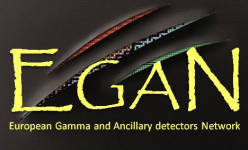
|
European Gamma and Ancillary Detectors Network |
|
This networking activity aims at the mutual coordination between the research groups involved in high-resolution gamma-ray spectroscopy to optimize the use of the valuable resources at the different infrastructures and to enhance synergies among researchers on a broad European scale, to ensure the sharing, design, construction and maintenance of detectors and associated equipment in a co-ordinated approach.
The study of the excited nuclear states and their decay properties is at the frontier in nuclear research and constitutes a very important fraction of the scientific programme at the Laboratories of ENSAR. The most powerful tool for these investigations is the high-resolution γ-ray spectroscopy which allows to search for new structure properties in nuclei far from stability and at the extreme conditions of excitation energy and spin.
The complex experiments planned at the different European infrastructures, involving both stable and radioactive beams, will require powerful and versatile gamma-ray detection systems coupled to ancillary devices for the detection of other observables and reaction products. The combination of such devices will reach very high sensitivity and will be able to study rare nuclear species and their related exotic phenomena and to test theoretical predictions. Presently, the most powerful and innovative Ge-detector array, AGATA, based on gamma-tracking techniques, is under construction and the first phases of construction will include a fraction of the 180 detectors planned for the complete array. Physics campaigns of AGATA in the different phases will be organized in
European laboratories for frontline research. In this context, EGAN will facilitate the coordination and the mutual exchange of information between the AGATA steering committee and the management of the involved hosting laboratories. Such action, that could be extended upon request to other gamma-spectroscopy collaborations, will help to ensure that frontier research is continuously ongoing and is well distributed among host laboratories, each with its specificity in beam species and energy ranges.
To carry out a well-coordinated scientific programme at the different laboratories of ENSAR, the co-operation on the sharing, development, construction and maintenance of equipments is of primary importance. This co-operation will give an added value to the resources, and therefore, to the hosting infrastructures, also in view of the present and future investments. For this networking the co-ordination plan concerns: i) the optimisation of the use of all the valuable and powerful resources available and ii) the design and construction of innovative, state-of-the-art complementary detectors that minimize the impact on the performances of the gamma detection. The specific goals in this connection are:
The Network will assure the exchange of information and transfer of knowledge by organizing workshops and training courses addressed to young physicists and engineers and exchange of technical personnel. It will also promote the collaboration with other research communities using similar tools and will encourage and support interdisciplinary ventures for the use of gamma-ray spectroscopy techniques in other fields.
This network has strong links with all TNA’s and the Joint Research Activities JRA04 (INDESYS), JRA05 (SiNuRSE), JRA08 (EWIRA), and JRA07 (THEXO).